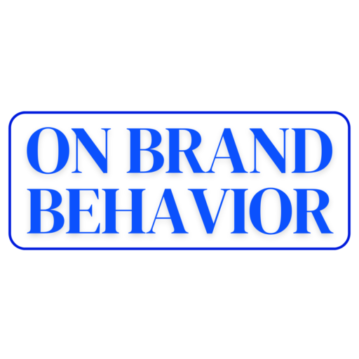Why do people choose one brand over another, even when the products are nearly identical? Why do some brands feel more “trustworthy” or “premium” while others struggle to stand out?
It’s not about logic—it’s about psychology. Consumers don’t make buying decisions based purely on facts. Instead, their brains rely on cognitive biases—mental shortcuts that influence perception, trust, and decision-making.
If you don’t understand these biases, you’re leaving money on the table. But if you do, you can position your brand in a way that makes buying feel effortless.
What is Cognitive Bias, and Why Does It Matter for Branding?
A cognitive bias is a mental shortcut the brain uses to process information faster. Instead of making rational, data-driven choices, people default to familiar patterns, emotional triggers, and subconscious associations.
Brands that understand these biases shape consumer perception in their favor. They don’t just compete on price or features—they win the battle for the mind.
Example: Why do people buy iPhones even when cheaper, technically superior smartphones exist?
• Familiarity Bias: Apple has been a trusted brand for decades.
• Authority Bias: Apple is positioned as an industry leader.
• Social Proof: Millions of users reinforce the idea that it’s the best choice.
• Scarcity Effect: New models have limited stock, creating urgency.
🚀 Takeaway: People don’t always choose the best product—they choose the best-branded product.
The 5 Cognitive Biases That Make or Break Brands
1. The Familiarity Bias: People Trust What They Know
The more people see a brand, the safer it feels. This is why brands like Nike, Coca-Cola, and McDonald’s dominate—not necessarily because their products are the best, but because they’re ingrained in the consumer’s subconscious.
Example:
• You walk into a store looking for a pair of headphones.
• You see a brand you’ve never heard of and a Bose or Sony option next to it.
• Even if the unknown brand has better specs, you’re more likely to pick Bose or Sony because you’ve seen those names before.
🔹 Brand Strategy: Show up consistently.
• Use content marketing, ads, and social presence to increase brand exposure.
• Stay top-of-mind so when consumers are ready to buy, they choose you.
2. The Authority Bias: People Follow Experts
Consumers trust brands that appear authoritative. They assume that industry leaders and experts know best—even when they don’t.
Example:
• If a skincare brand is recommended by dermatologists, people assume it’s better.
• If a product has a “#1 Best Seller” label, sales increase—even if it’s self-proclaimed.
• If an entrepreneur is featured in Forbes, Business Insider, or TED Talks, their credibility skyrockets.
🔹 Brand Strategy: Position yourself as an authority.
• Get press features, certifications, endorsements, and media exposure.
• Use trusted figures or influencers to promote your brand.
• Highlight real-world expertise and case studies.
3. The Social Proof Bias: People Follow the Crowd
If everyone else is buying it, it must be good. That’s how the brain processes decisions when uncertainty is involved.
Example:
• Restaurants with long lines appear more desirable than empty ones.
• People trust Amazon products with thousands of 5-star reviews more than those with few.
• Fashion brands use celebrity endorsements and influencer marketing to create desirability.
🔹 Brand Strategy: Leverage social proof.
• Display testimonials, case studies, and user reviews.
• Show customer count (“Over 10,000+ happy clients!”).
• Use “As Seen In” credibility markers (Forbes, Fast Company, Business Insider, etc.).
4. The Scarcity Effect: People Want What’s Limited
When something is rare or exclusive, it feels more valuable.
Example:
• Luxury brands like Rolex and Hermès limit production to maintain exclusivity.
• Airlines use “Only 2 seats left at this price!” to create urgency.
• Concert tickets and “Limited Edition” releases sell out faster due to perceived scarcity.
🔹 Brand Strategy: Create controlled scarcity.
• Offer limited-time pricing or bonuses for early buyers.
• Launch exclusive, members-only products or VIP experiences.
• Use “only X left” countdowns or low-stock alerts on your website.
5. The Anchoring Bias: First Impressions Shape Perception
People rely on the first piece of information they see when making a decision. This is why brands use price anchoring, premium positioning, and high-ticket offers to set the tone.
Example:
• A $1,500 coaching program makes a $500 course feel like a bargain—even if $500 seemed expensive before.
• A menu at a restaurant places the most expensive dish first, making the other options feel affordable.
• A SaaS company offers a $99/month plan first, then a $29/month plan—$29 suddenly feels cheap.
🔹 Brand Strategy: Control the first perception.
• Introduce a high-ticket offer first, making mid-tier options seem more affordable.
• Use premium pricing to signal quality—cheap often feels low-value.
• Structure pricing so your main offer looks like the best deal.
How to Apply Cognitive Biases to Your Brand (Right Now)
✅ Show up everywhere (Familiarity Bias).
✅ Position yourself as an expert (Authority Bias).
✅ Use testimonials, press, and customer counts (Social Proof Bias).
✅ Create urgency and exclusivity (Scarcity Effect).
✅ Frame pricing and offers to feel like the best deal (Anchoring Bias).
Brands that understand consumer psychology don’t just attract buyers—they build long-term trust and dominance.
What’s Next?
If you want to use branding psychology to build a more influential, trusted, and profitable brand, check out On Brand Behavior’s resources for deep-dive insights.
💬 Which cognitive bias do you see brands using the most? Let’s discuss below!
